The oceans are notoriously opaque, providing the submarine with a strong veil of stealth. The only thing that oceans don't effectively block is sound, which is transmitted more effectively through water than it is through air. As a result, sonar remains the main method of detecting submarines, either in active form, producing sound that bounces off the target and is reflected back, or in passive form, listening for noise from the target. But sound doesn't travel through the ocean in a straightforward way, and as sonar has grown more sophisticated, its operators have had to contend with effects that either attenuate the sound, drown it out or bend it in surprising ways.
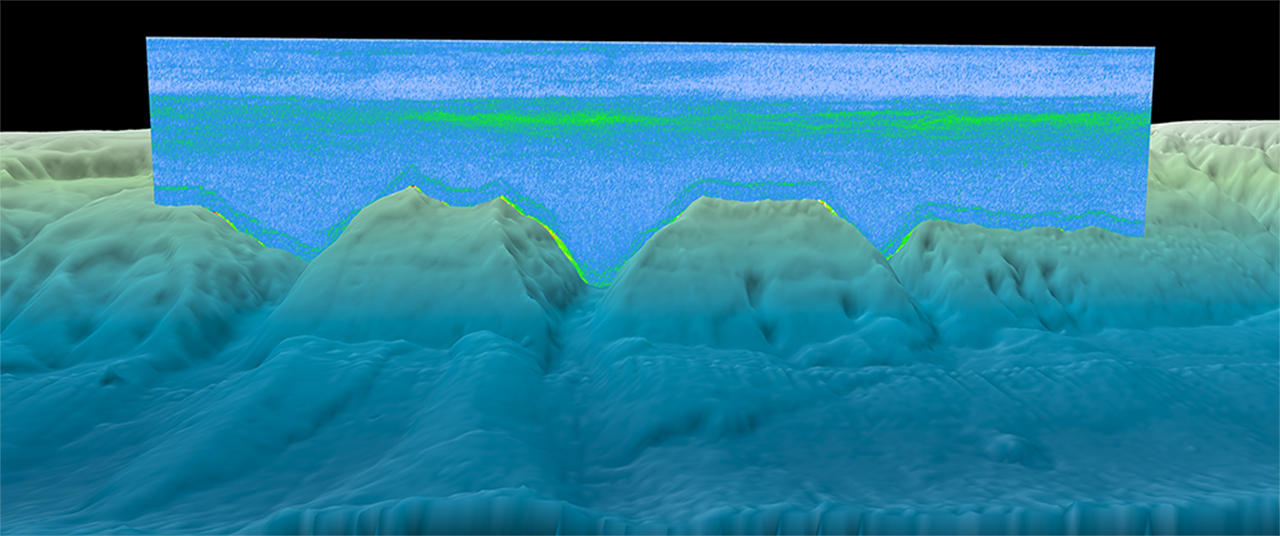
The Deep Scattering Layer (green) on a sonar scan
Attenuation can come from a number of sources. Obviously, the intensity of a sound weakens as it spreads out from its source, and in an infinite ocean, this would follow the inverse square law. In practice, it's often lower than this, thanks to effects discussed later, but the ocean doesn't transmit sound perfectly. Some is absorbed and turned into heat, a process that occurs more strongly at higher frequency. Some is scattered when it runs into discontinuities, which can be the surface and bottom of the sea or solid objects in the ocean, usually marine life. Most notable is the deep scattering layer, composed of deep-sea fish and the plankton they feed on that tend to cluster a thousand feet or so below the surface. Scattering is a particular problem for active sonar, as the reverberations from the surface/bottom/creatures can make it hard to pick up the actual return.
Sonar also has to contend with background noise, of which there is a lot in the ocean, although unevenly distributed across frequencies. Low-frequency noise is poorly understood, but includes factors like turbulence in the ocean and seismic activity. At higher frequencies, noise is caused by distant shipping, wind and wave activity on the ocean surface, and even the movement of water molecules. Other sources of background noise can also complicate matters. Nearby shipping, drilling, or the use of explosives for oil exploration can drown out a submarine. Biological sources of noise, such as snapping shrimp, croaking fish, or cetaceans (whales and the like), are generally easy to identify, but also raise the background. And seismic activity is a problem in geologically active areas like the mid-Atlantic Ridge.
But the real fun comes from looking at the paths sound takes through the ocean. These are very complicated, but come from some quite basic physics. The speed of sound in water increases with each of increasing temperature, pressure and salinity, and per Snell's Law an increase in the speed of sound will change the angle of an ray of sound passing through it. The effect of Snell's Law is that rays bend towards areas where the speed of sound is low, and away from places where it is high, producing some quite intricate paths.
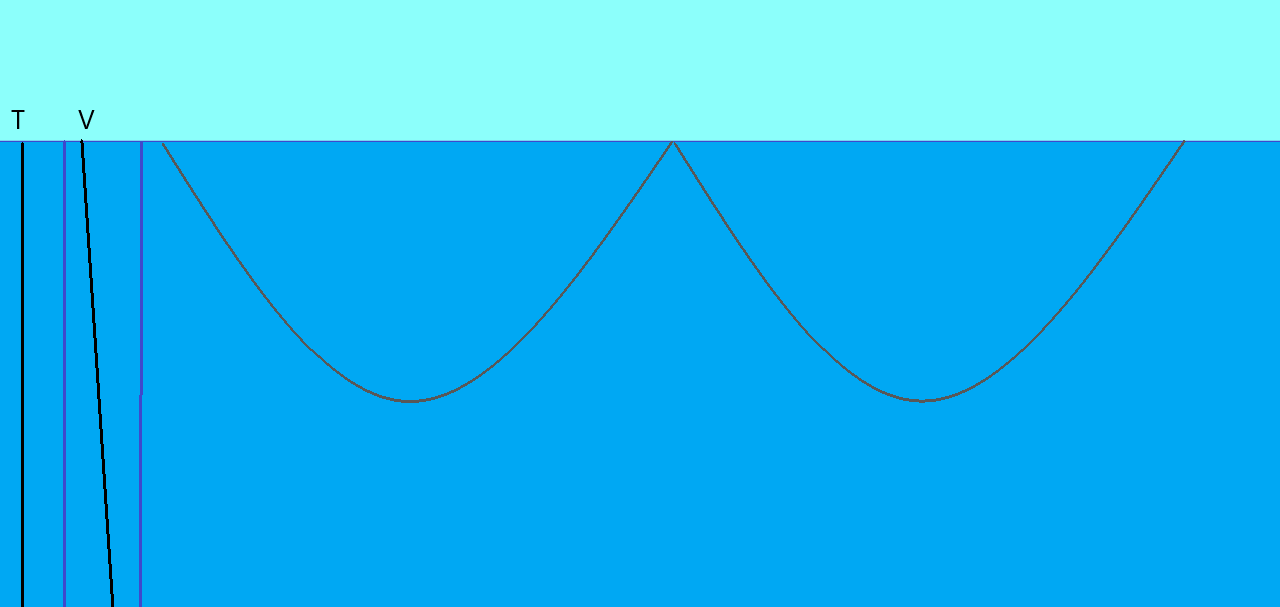
Half-channel propagation1
The most basic case is one where salinity and temperature are constant throughout the water column, leaving only the effects of pressure, which obviously rises with depth. The result is increasing velocity with depth, which will bend the sound back towards the surface a ways away from where it started. When it reaches the surface, it might, depending on frequency and the state of the sea surface, bounce off it without too much scattering and continue on, a phenomenon known as the half-channel, common in the Mediterranean and the Arctic. This dramatically cuts down losses from signal spread, as the energy from the sound source is spread in two dimensions instead of three dimensions.
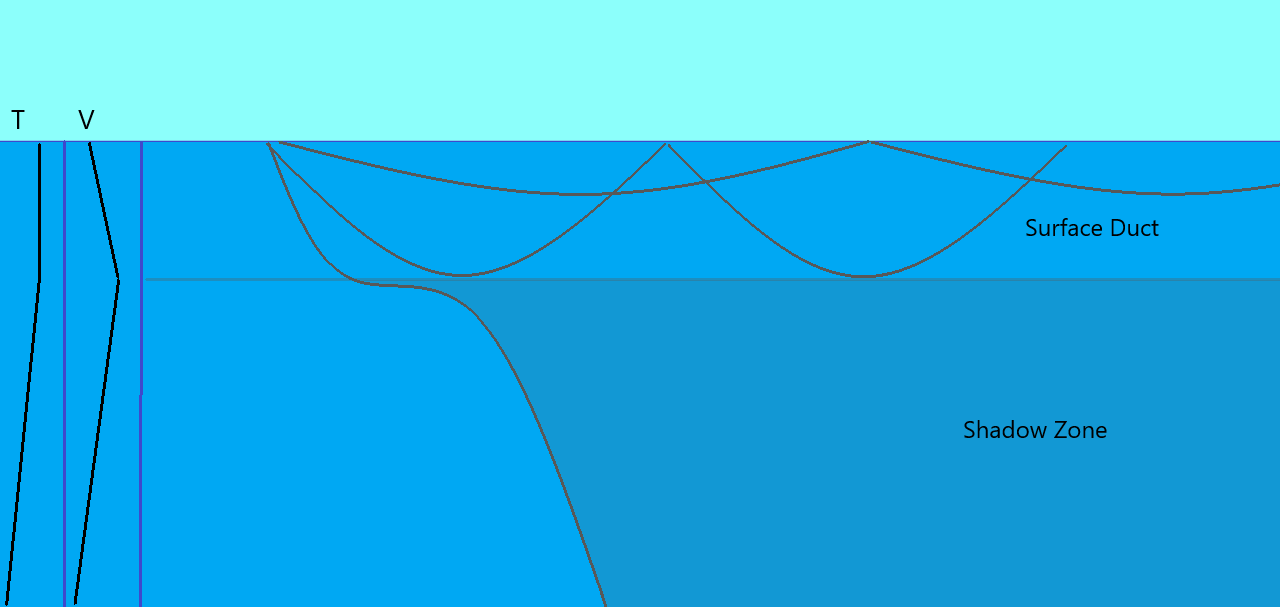
The surface duct and shadow zone
But temperature is rarely constant in the water column, producing more interesting effects. In the deep ocean, a cloudy, windy day will typically mix the water near the surface and produce an isothermal layer down to a few hundred feet, resulting in something quite similar to half channel propagation for objects near the surface, known as the surface duct. However, below the layer is a gradient of decreasing temperature which overwhelms the effects of pressure, bending sound downward. This produces a "shadow zone" below the layer where a sonar near the surface can't see, an effect that submarines like to exploit. Counters to this include variable-depth sonars, which have a towed body that can be lowered below the layer, and finding a path that bounces off the seabed. Exploiting bottom bounce is rather difficult, as the bottom has to be smooth enough to reflect well and not so hard that it absorbs a lot of the signal, as well as being at the right depth. It also suffers from constructive and destructive interference, which means that signals tend to peak and fade unpredictably.
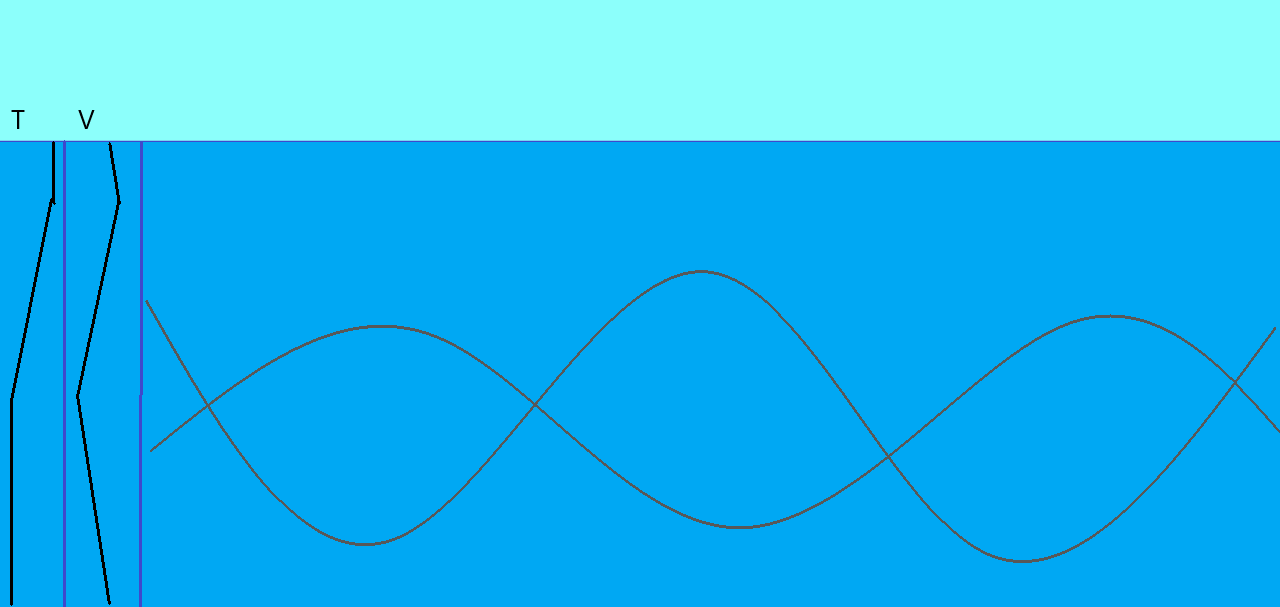
The Deep Sound Channel
Temperature (and thus sound velocity) below the layer drops off fairly consistently until it reaches the 4°C of the deep ocean several thousand feet down, at which point pressure takes over and sound velocity begins to rise again. The result of this minimum in sound velocity is that rays on either side are bounced back towards it, producing the so-called deep sound channel. The US and its allies made extensive use of the Deep Sound Channel during the Cold War to track Soviet ships and submarines, sometimes across an entire ocean basin. Smaller sound channels sometimes form higher in the ocean, although far less predictably and over shorter distances.
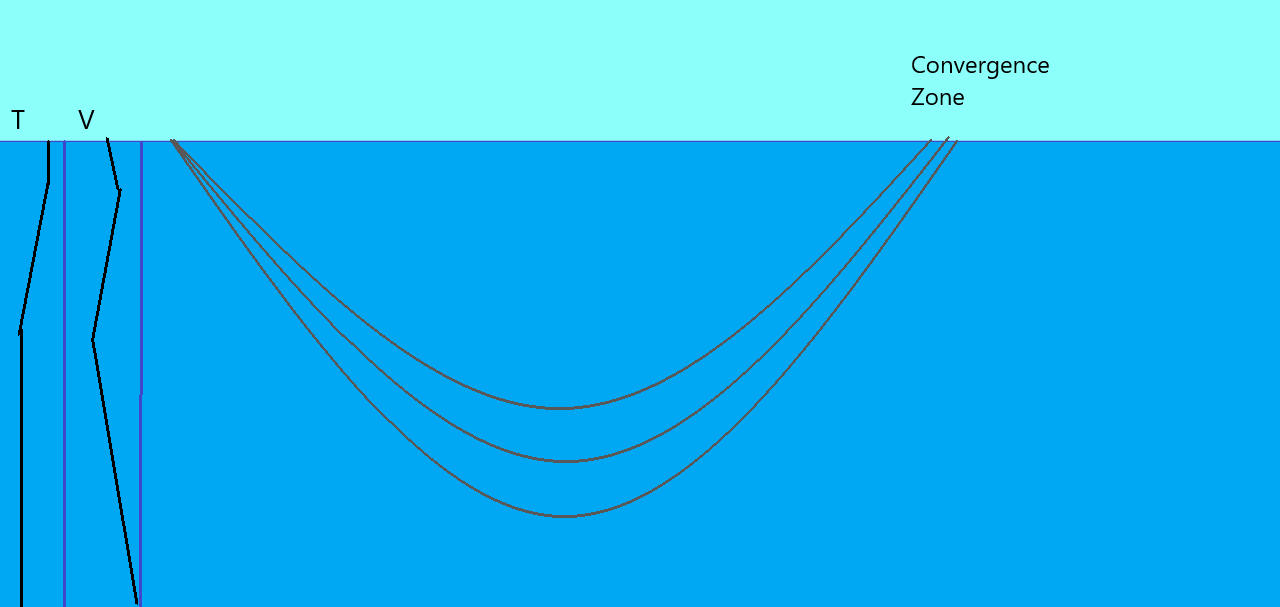
A Convergence Zone
A related and more tactically useful phenomenon is the convergence zone, where the same process that produces the deep sound channel focuses noise near the surface at specific distances from the target. This only occurs in reasonably deep water, usually over 2000', and produces a set of "rings" that raise the volume of the target by 15-20 dB,2 a major boon for ASW forces. Exactly how far out the convergence zones are varies depending on local conditions, but the innermost convergence zone usually is somewhere between 20 and 35 nm out, with subsequent CZs at multiples of that distance. Each covers 5-10% of the distance from the target, and they play an important part in long-range ASW, with helicopters often sent out to nail down and kill submarines picked up in the convergence zones.
Not mentioned so far is salinity, the third factor that can affect the speed of sound in the ocean. For most of the ocean, it can be ignored because it is stable throughout the water column, but it becomes a problem when two bodies of water of different salinity mix, either due to ocean currents or particularly in shallow waters where rivers run into the ocean. The result is a complicated and unpredictable set of sound paths, made even more convoluted by the topography of the bottom. The result is that hunting submarines in shallow coastal waters remains the most difficult challenge for anti-submarine forces.
Of course, this is only the broadest overview of underwater acoustics as applied to modern anti-submarine warfare. Books have been written on the subject, taking into account not only the things mentioned here but also issues like bottom topography and the differences between active and passive sonar. But at the very least, this should give a decent idea of how the primary underwater sensors have worked for the past century.

Comments
In the sixth paragraph, the sentence "This produces a “shadow zone” below the layer where a sonar near the surface can see, an effect that submarines like to exploit." seems to be missing a "not."
Yeah, that was a typo. Fixed now.
You talk about active sonar being too dangerous to use for submarines. Does a similar logic hold for fleet escorts?
Have they found any clever PPI-style ways to visualize sonar returns in a way that helps build a picture of the battle area?
"We don't hear anything there, but would we know if there was?" Seems like a big issue in a way that makes it even harder to coordinate ASW than air defense.
If you're trying to protect a carrier, is there some way to show likely blind spots in your coverage overlaid on a map, so you don't drive right over some silent running diesel boat with a suicidally brave crew?
All the movies seem to just extrapolate from WW2 when it comes to submarine warfare of all kinds.
@ike
No, because a fleet escort's strength doesn't like entirely in its stealth. A submarine is almost never going to have a range advantage over its enemies (ASMs aside, but you're not going to target those with active sonar) so by giving away your position, you're inviting immediate retaliation. A surface escort can use ASROC or a helicopter to reach out a lot further.
@Echo
They'll often use ray-tracing programs to try to figure out how sound is going to bend, with the intent of placing sensors properly. Wouldn't be surprised if there's a way to visualize that on the displays. Say a circle beyond which the shadow zone falls. But I don't know of any details because that stuff is all classified.
What gets classified would make an interesting post at some point (or maybe you've already covered it and I forgot?).
It must be weird to work in a field where the open scientific research and commerical application have this dark wall of secrecy at the advanced end.
Aeronautics must be a huge one for that, but it seems like everything from acoustics to optics to compsci is the same way now.
@bean
I suppose one way to figure out those details is to use your knowledge of the subject to come up with a plausible visual display and see to it that it gets used the next time Hollywood touches on the subject. If the FBI comes to ask you uncomfortable questions, you got it mostly right.
(Hey, it worked for Kubrick and the B-52 cockpit!)
@Echo
That's not likely to get covered because it would take a combination of wading through policy documents (which I won't do unless someone pays me) and probably a lot of sociological research which I'd need permission for. The short version (based on personal experience and no data) is that it's idiosyncratic. Generally, it's going to be based on how much use the other side can make of the information and how easy it will be to keep hidden, but they're going to error on the side of not releasing things if they're adjacent to classified stuff. Also worth noting that classified doesn't mean interesting. My first few years with a clearance basically gave me permission to be in the same room with codes and see some stuff that could probably, in the hands of a very clever person, give a bit of information.
@Matt R
Probably wouldn't work. I could make some guesses on how they'd display, but I think they'd be different enough it wouldn't make anyone pay attention.
@Matt R
That assumes the FBI know how the correct submarine display looks like.
Here in Israel a few years back someone had left a music CD labeled "Jericho 4 - Nuclear and Improved" in their car. Their car was parked near a military base but then again, there are military bases all around Tel Aviv.
Neither that person nor the CD had any relation to the Israeli nuclear missile program, it was just an ordinary CD full of ordinary music with a cocky label, but they still got quite an interrogation from the security services.
Can they synthesise sonar data from multiple vessels, like how astronomers used very long baseline interferometry to resolve black holes last year?
I'm pretty sure that was how a lot of SOSUS worked, but those were fixed arrays. I would be extremely unsurprised if someone was doing it with sonobuoys, although I don't think I've run across explicit references to it. Less sure it's being done between ships, because ASW funding fell off a cliff around 1990, and nobody has any reason to want that capability that strongly.
Where is the Chinese submarine force qualitatively compared to the Russians?
Without knowing much about it, they seem under invested and under developed compared to their other forces, but I wonder how good what they do have is.
Having done some research on undersea stuff lately I can say that yes various marine patrol aircraft are quite capable of using the sonar results from more than one buoy at a time. But each buoy is still a self contained transmitter and receiver.
On synthesizing sonar data from multiple vessels, Google for "multistatic sonar". Not quite what you're asking but these are techniques being developed for having a large area array of receivers that pick up and report echoes from any transmitter, not just their own. A computer with the big picture figures out what all the individual reports add up to.
Generally CZ propagation only occurs in warmer waters (in a given area, CZs are visible in the summer but not the winter). Can you explain this?
I'm not sure that's true. One source (the new Cold War ASW from Friedman) identifies warm surface waters as hindering CZ formation, and gives summer and winter numbers for CZ ranges in most areas. The exception is the Med, where higher evaporation in the summer raises salinity and thus the deep sound channel, which makes CZs possible in that relatively shallow sea. The source I used to write this post doesn't mention anything about a seasonal effect.
Cold air, lack of sunlight and rough waters can create a much deeper and stronger mixed layer that traps sound in the surface duct. Preventing it from ever entering the thermocline and deep isothermal layer to eventually return to the surface. At least for mid-high frequencies.
@Jim, my notes from the (unclassified) Undersea Warfare Short Course I did in 2022 say that Convergence Zones are mostly the result of pressure, not temperature. Really needs a depth of 1500 metres or more for a CZ to form.
Temperature does affect other aspects of sound propagation, in particular the thermocline layer which also bounces sound waves and provides shadow zones for subs to hide in. Could you give more details about your source?